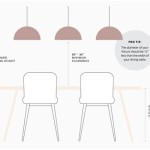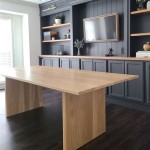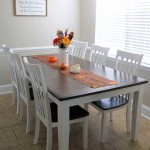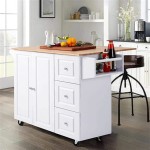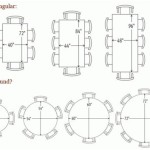Styling A Square Coffee Table: A Comprehensive Guide
The square coffee table serves as a central anchor in many living rooms, offering both functionality and aesthetic appeal. Effectively styling this surface can significantly enhance the overall ambiance of a space, transforming a simple piece of furniture into a stylish focal point. This article provides a detailed guide to styling a square coffee table, covering various design principles, element selection, and practical considerations.
Understanding the Proportions and Scale
Before embarking on the styling process, it's crucial to understand the proportions and scale of the coffee table in relation to the surrounding furniture and the room itself. A coffee table that is too large can overwhelm the space, while one that is too small may appear insignificant. Ideally, the coffee table should be approximately two-thirds the length of the sofa and positioned about 12 to 18 inches away from the sofa to allow for comfortable movement. The height should be roughly the same height as the sofa seat, or slightly lower.
Analyzing the dimensions of the coffee table is equally important. A larger square coffee table will naturally accommodate more items, allowing for a more elaborate arrangement, while a smaller one requires a more minimalist approach. Consider the visual weight of the table itself. A solid wood table will have a heavier presence than one with a glass top and metal legs, influencing the choice of decorative elements.
Furthermore, the overall style of the room should be considered. A contemporary living room will call for a different styling approach than a traditional one. Take into account the color palette, textures, and existing decor to ensure that the coffee table styling complements the existing design scheme.
Selecting Key Styling Elements
The selection of styling elements is paramount in creating a visually appealing and functional coffee table arrangement. Common elements include books, trays, decorative objects, plants, and coasters. The key is to curate a collection of items that are both aesthetically pleasing and reflective of the homeowner's personality and interests.
Books are a classic choice for coffee table styling, adding height, visual interest, and a touch of intellectual sophistication. Choose books that are visually appealing, with interesting covers or spines. Stack them horizontally to create a platform for other decorative objects, or arrange them vertically with bookends. Different sizes and thicknesses of books can add dimension to the arrangement.
Trays serve as anchors, grouping items together and creating a sense of order. They can be used to hold smaller objects, such as candles, coasters, or remote controls. Choose a tray that complements the style of the coffee table and the room. Options include wooden trays for a rustic look, metal trays for a modern aesthetic, or mirrored trays for a touch of glamour. The size of the tray should be proportionate to the size of the coffee table.
Decorative objects add personality and visual interest to the arrangement. Consider incorporating items that reflect personal interests, such as sculptures, vases, or travel souvenirs. Vary the size, shape, and texture of the objects to create a dynamic composition. Avoid overcrowding the coffee table with too many items; less is often more.
Plants bring life and vibrancy to the coffee table. A small potted plant or a succulent can add a pop of color and freshness to the arrangement. Choose a plant that is appropriate for the light conditions in the room and that complements the overall style of the space. Artificial plants are also an option for those who prefer low-maintenance greenery.
Coasters are essential for protecting the coffee table surface from scratches and stains. Choose coasters that are both functional and stylish. Options include wood, stone, leather, or metal coasters. Consider selecting coasters that complement the other items in the arrangement.
Arrangement Techniques and Styling Principles
Once the key styling elements have been selected, the next step is to arrange them in a visually appealing manner. Several arrangement techniques and styling principles can be employed to create a cohesive and balanced composition.
The rule of thirds is a fundamental design principle that can be applied to coffee table styling. Divide the coffee table into thirds, both horizontally and vertically, and arrange the items along these lines or at their intersections. This creates a sense of balance and visual interest.
Creating visual triangles is another effective technique. Arrange items in triangular formations, varying the height and size of the objects. This draws the eye around the arrangement and creates a sense of dynamism.
Varying the height of the objects is essential for creating visual interest. Use books or stacked objects to elevate certain items and create a sense of dimension. Mixing tall, medium, and short items will prevent the arrangement from appearing flat and monotonous.
Balancing the weight of the objects is crucial for creating a cohesive composition. Avoid placing all the heavy objects on one side of the coffee table; instead, distribute them evenly. This will prevent the arrangement from feeling unbalanced.
Leaving negative space is just as important as filling the space with objects. Avoid overcrowding the coffee table with too many items; allow for some empty space to create a sense of airiness and prevent the arrangement from feeling cluttered. Negative space allows the individual items to stand out and be appreciated.
Rotating the items periodically can refresh the look of the coffee table and keep it from feeling stale. Rearrange the objects, swap out certain items for others, or simply rotate the tray. This will keep the arrangement looking fresh and interesting.
Consider the functionality of the coffee table when styling it. Ensure that the arrangement does not impede the use of the table for its intended purpose, such as placing drinks or snacks. Avoid placing fragile or easily breakable items within reach of children or pets.
Specific Styling Examples Based on Coffee Table Shape and Size
The shape and size of the square coffee table greatly influence the styling approach. A large square coffee table offers more versatility in terms of arrangement options, while a small square coffee table requires a more minimalist approach. Here are some examples of how to style a square coffee table based on its size and shape:
Large Square Coffee Table: For a large square coffee table, consider dividing the surface into four quadrants and styling each quadrant differently. One quadrant could feature a stack of books topped with a decorative object, another could hold a tray with candles and coasters, a third could feature a potted plant, and the fourth could be left empty for functional use. This approach creates a sense of balance and visual interest, while also providing ample space for everyday use.
Medium Square Coffee Table: A medium square coffee table can be styled with a more streamlined approach. Consider placing a large tray in the center of the table and arranging a few carefully selected items on the tray, such as a candle, a small plant, and a decorative object. Alternatively, a stack of books topped with a sculptural piece can create a focal point, while leaving the remaining space uncluttered.
Small Square Coffee Table: For a small square coffee table, simplicity is key. Focus on a single, impactful element, such as a beautiful bowl or a striking sculpture. Alternatively, a small tray with a few essential items, such as coasters and a remote control, can be both functional and stylish. Avoid overcrowding the table with too many items; instead, prioritize a clean and minimalist aesthetic.
Materials and Textures Considerations
The choice of materials and textures of styling elements is crucial for creating visual interest and depth. Mixing different materials and textures can add a layer of sophistication to the coffee table arrangement.
Consider incorporating natural materials, such as wood, stone, or woven baskets, to add warmth and texture to the coffee table. These materials can create a sense of grounding and connect the arrangement to the natural world. Contrast these materials with smoother surfaces, such as glass or metal, for a more dynamic composition.
Varying the textures of the objects can also add visual interest. Combine smooth, polished surfaces with rough, textured surfaces to create a tactile experience. For example, a smooth ceramic vase can be paired with a textured woven tray. Layering textures can create a sense of depth and complexity in the arrangement.
The color palette of the styling elements should also be considered. Choose colors that complement the existing decor of the room and create a cohesive aesthetic. Consider using a mix of neutral colors and pops of color to add visual interest. The color of the coffee table itself should also influence the choice of styling elements. A dark coffee table may benefit from lighter-colored objects, while a light coffee table may benefit from darker-colored objects.
Ultimately, the styling of a square coffee table is a matter of personal preference and artistic expression. By following these guidelines and experimenting with different elements and arrangements, anyone can create a stylish and functional focal point in their living room.
.jpg?strip=all)
How To Style A Square Coffee Table Dream Green Diy
.jpg?strip=all)
How To Style A Square Coffee Table Dream Green Diy

Jenni S Comprehensive Guide To Coffee Table Styling Kayne
:strip_icc()/cdn.cliqueinc.com__cache__posts__248681__how-to-style-a-coffee-table-248681-1517858283553-fb.700x0c-a3b7571b29fd4836a01221dd7ce30466.jpg?strip=all)
How To Style Your Coffee Table Once And For All

3 Steps To Easy Breezy Coffee Table Styling A How Guide
:strip_icc()/cdn.cliqueinc.com__cache__posts__248681__how-to-style-a-coffee-table-248681-1517858299660-image.700x0c-855cdf9127ca4bd0840bd0c9463eebd8.jpg?strip=all)
How To Style Your Coffee Table Once And For All

Tried And True Tips How To Style A Coffee Table Sand Sisal

How To Style A Coffee Table Erika Brechtel
.jpg?strip=all)
How To Style A Square Coffee Table Dream Green Diy

15 Designer Tips For Styling Your Coffee Table Hgtv

